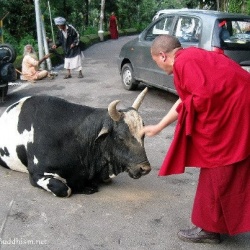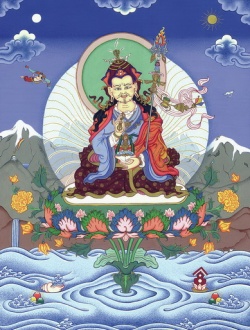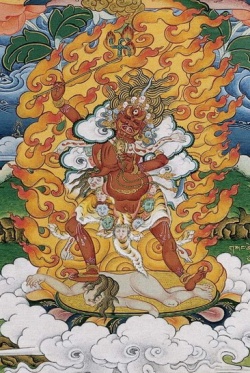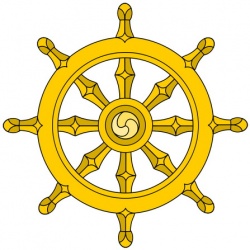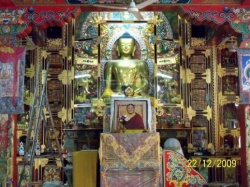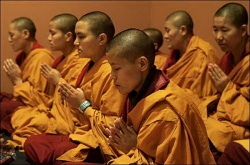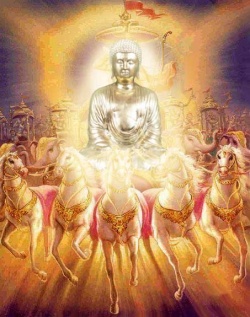Buddhism, Nihilism, Objects
I've been having a fascinating discussion with Christopher Ireland concerning my recent essay in Adbusters. I'm reproducing it here as it elucidates some issues I've explored on the blog. And it may be interesting for non-Buddhists to see issues such as nihilism and existence being debated within Buddhism. The conversation is ongoing.
Here is the passage in my essay we've been discussing:
Modern life presents us with a choice:
1) The essence of things is elsewhere (in the deep structure of capital, the unconscious, Being).
2) There is no essence.
At present I believe that the restriction of rightness and coolness to this choice is one reason why planet Earth is in big trouble right now. And I believe that the choice resembles a choice between grayish brown and brownish gray.That’s why I believe in option 3):
3) There is an essence, and it’s right here, in the object resplendent with its sensual qualities yet withdrawn.
C: wherefore Nagarjuna? Or is 3) a modern reformulation of Yogacara?
T: Does Nagarjuna argue that nothing exists?
C: No, he doesn't, but he does argue that things don't have essences.
T: This glass is identical to this pen, since it has no essence?
C: In terms of having no essence, then of course the pen and glass are identical. You know how all the arguments go at least as well as I do. Causes and conditions. Interdependent arising. My question really is, therefore, why you would choose 3) over 2)?
T: You see emptiness as different from the glass?
C: Emptiness isn't a thing, and as such can't be different or identical to things. If I say to you that I have no money, you can't then ask me to give you the money I don't have.
T: Do you disagree with the phrase "emptiness is no other than form"?
C: Not at all. Emptiness is the interdependence of form - without form there would be no emptiness to speak of. And if form really did have independent essence, there would be no form to speak of either.
T: For something to be interdependent with something else, it has to be different, right? If it was the same, it couldn't be related to it--because it would be exactly the same. Yes?
C: Difference is relative to identity. There would be nothing that appeared the same if there wasn't anything that appeared different. Why do some things appear different whilst others appear identical? Is this difference and identity a characteristic of the object? Or a characteristic of the mind of the observer? Where is difference and identity?
T: This glass is the same as an "identical" glass?
C: If two things were identical in all aspects we could never see them as two things. Then we have the situation described by the Goliath and Lumpl example ( http://plato.stanford.edu/entries/supervenience/#5.5 ). We could say that emptiness is a defense of a negative answer to the "grounding problem". Does OOP offer a positive answer to this problem?
T: Hi Christopher. I seem to be making some progress here towards understanding your position. It seems as if for you, emptiness is the essence of things: it subtends the glass and the pencil equally. Now you may not like the term "essence" but here and in my piece it doesn't mean "ground." To think it thus is more like what you are doing, so ironically you seem to adhere to position 1). I put it to you that you are really advocating position 1). The essence of things is "elsewhere" than their form. No matter how this glass appears to me, really it is not a glass, just an appearance of one. Yet you are worried about the idea of essence at all, and so you also want to assert 2: "there is no essence."
In Madhyamika this is known as rangtong: "emptiness of self." "Lack of essence" as you say. Yet your agreement with me about the difference between a glass and an identical glass suggests that there remains a puzzle concerning what to do with appearances. For the rangtong view, the glass is only a mistaken appearance of a generalized emptiness.
But there is a higher view of emptiness, known as shentong, "emptiness of other." This is the fully Prasangika Madhamaka view, via which I have been questioning you. Emptiness is not just blah or nothing at all. It is endowed with all the qualities of a Buddha. The glass is not empty despite its glass-ness, but because of it. Position 3) is akin to the shentong view of emptiness.
I highly recommend that you read Khenpo Tsultrim Gyamtso, Progressive Stages of Meditation on Emptiness.
Most Westerners do indeed think that emptiness is nothing at all or that it underlies things (somewhere between positions 1 and 2). This view tends towards nihilism, which as I suggest, is part of the big problem modernity has. Either there is no essence (2)--emptiness is just "lack of essence." Or there is an essence, but not in appearance.
This is a big mistake, first introduced by Hegel. See my essay "Hegel on Buddhism," which you can find online. The glass analogy was first used by my teacher, Tsoknyi Rinpoche. For him, the reason why the glass embodies emptiness is not because it isn't real--but because it is. This is because he accepts the highest possible view of emptiness, the shentong.
The key to my diagnosis of nihilism was when you said that emptiness was neither "in" nor "not in" the glass. This is the fourth possible mistake Nagarjuna outlines in his tetralemma. The neither-nor position is nihilism. On this view, it doesn't matter that the glass is a glass. Likewise, it might not matter whether you meditate or commit a murder: both are equally devoid or essence, right? Danger.
Daniel Taghioff said...
If emptiness is not a thing, but a lack (of essence) then one must ask what is there.
What is there is a multiplicity. A multiplicity of objects and of relations if you like. The point is that to seek an essence is the problem, even an essential lack, which posits the lack as an object/essence in itself (which is the basis of nihillism).
That is why "objects" is a problem. It may be a corrective to seeking relations, but it is also an attempt at an essence. Why should the world in all its multiplicity primarily be made of "objects" and why should those objects "withdraw" rather than also overflow in all their multiplicity?
Indeed how can "object" or "difference" be one essence? To say so is to attempt some kind of Zermilo Frankel formulation of everything, but that is not possible, when you approach everything or the infinite, as Cohen and Godel have shown, for the continuum hypothesis as well as for the axiom of choice, Zermilo Frankel ceases to be able to decided either way. In other words no singularised set function
If you ignore multiplicity you are forced to create quasi objects to explain how relations can exist overlain on objects. But the answer is simple, all is multiple, all is sets of sets if you like (as Cohen and ZF require and Badiou elaborates), so all interaction is partial, some parts of a multiple interact more than others and this makes objects in relation respond distinctively, it is the basis of emergence and articulation.
So no, essence does not lie in objects here and now, that is to priviledge the immediate and the bounded. The issue is even simpler, there are no essences, only the dynamic multiplicity that we sometimes, in their slow motion, see as objects.
Yes, objects have distinctive dynamics and internal coherence by definition, but everything does to some degree. However whatever you say about them is an attempt to place a "set function" in front of multiplicity, it is an attempt to essence. To abandon essences is not to go to nihilism, it is to acknowledge the incredible fullness of everything, in all its multiplicity.
The conversation continues. Now with extra Marcus Boon!
Christopher Ireland: Oh yes, I'm much more rangtong than shentong, you are quite correct in your diagnosis. However, you are quite incorrect to suggest that shentong is the superior view. You may be interested in the following book chapter entitled "Is there such a thing as Shentong-Madhyamika?" written by the Kagyu scholar Karl Brunnhölzl:
http://tiny.cc/tmxf5
In this vein I would thoroughly recommend Klaus-Dieter Mathes' "A Direct Path to the Buddha Within: Gö Lotsawa’s Mahāmudrā Interpretation of the Ratnagotravibhāga" for a very detailed analysis of rangtong and shentong within the Kagyu Mahamudra tradition.
In my opinion, to call the rangtong view nihilism is simply to misunderstand what Nagarjuna calls "the emptiness of emptiness". Once this is understood, appearances become very much easier to deal with, as when it becomes clear that there is nothing above, behind or beyond them one is not so distracted. As you yourself allude to, the accusation of nihilism towards rangtong is a symptom of 1), as this svabhava way of thinking can only conceive a negation of essence as an affirmation of its non-existence. This most certainly is not an issue of mine.
In my first reply to you, I asked you if position 3) was a reformulation of Yogacara. If you do read that chapter by Karl Brunnhölzl, you will see I was referring to shentong. So yes, I guess my original diagnosis of 3) has been confirmed.
So here we are, centuries later, still running around this old chestnut. Cool :)
Tim Morton: Hi--the rangtong view is not nihilism. But you veer close to it by saying that emptiness is the simple absence of anything. At least now we know where we stand and that I haven't forgotten Nagarjuna.
I must say I'm not convinced a Kagyü guy (being one myself) would argue that way, the way the author you mention does. I shall look at this.
One more thing though: if the glass is a mere illusion, how do you know it's an illusion? Isn't it the case that if the glass is just a manifestation of a deeper emptiness, which according to you is total nonexistence, then your perceiving mind doesn't exist either? How can you know anything real?
..and "the emptiness of emptiness" is Chandrakirti. I'm afraid he may agree with me that positing emptiness as anything (such as nonexistence, as you do), is to fall into theism or nihilism. This is why I use Prasangika Madhayamaka, as does Khenpo, who by the way is a Mahamudra master. The whole debate against the Gelugpas was that shentong was definitive. I don't need a scholar to tell me that!
...as for the Yogacharins, they stuck their middle fingers in wax and burned them down to the root to prove their faith in emptiness. By contrast, I am just a simple meditator. There's no need to go that far! So no, I'm not a Yogacharin, and I don't think the argument is particularly Yogacharin. But you seem to need to put me in a box.
Marcus Boon: A fascinating debate ... I don't have my books with me, so I can't check what KTG said in his Emptiness book. My understanding is that various people have associated Yogacara and Shentong because they share a belief in a kind of stainless or groundless ground of being -- the ocean of mind in the case of Yogacara, some kind of stainless awareness or thusness in the case of Shentong (Dolpopa talks about Shentong in terms of stained and unstained), The Prasangikas generally would say there is no essence and that the appearance of the object is just the coming together of causes and conditions through acts of designation or labelling. It's a tricky point, but I think generally a Prasangika would say that there is no object per se (since everything lacks self-existence), and no withdrawn object either, all you can speak of is an object that appears. That object which appears either has no essence since it appears in dependence on causes or conditions ... or ... well, Tim, you seem to be saying that the essence of the object is the way in which it appears. The way in which the object appears is empty of self-existence. Thus shunya ... and shunyata. Khenpo Tsultrim's version of Shentong, if I recall, says that the Prasangika positions, outlined thus, is correct, but that there is a stainless ground there, which is the same as emptiness, therefore also the same as the relative forms which arise in/as emptiness ... but which appears as essence or ground to the advanced meditator. But ... he doesn't say that it's an object. And this is where I struggle with the OOO stuff ...if the object that appears "withdraws" or "dissolves" into emptiness ... then it's no longer an object. As soon as you posit it as a withdrawn object you're introducing a concept into something that's been defined in advance as being non-conceptual, because it's free of the stains of relative existence. You can't even call it "something" or "it" ... it's not ontic, or ontological ... but it's also not nothing.
Maybe we should be talking about a luminous awareness oriented ontology?
Note that most Prasangikas would say that KTG's assertions mean that he's not really a Prasangika Madhyamaka. I'm attracted to his point of view, as you are, Tim ...
C: It is a fascinating debate, and I most certainly intend it as an open ended one and not as a device to prove my view superior to yours by boxing you into an inferior one. I too struggle with OOO in the same was as +Marcus Boon does, hence my reason for entering into conversation with you in the first place.
To begin with, the words "emptiness of emptiness" were not pronounced by Nagarjuna in his Mulamadhyamakakarika, to my knowledge. However, he does make the point very clear in XIII:8 ( http://goo.gl/hBEi6 ), in XXIV:18-40 he makes a detailed analysis of it ( http://goo.gl/f54jN ) and the text ends with a clear pointer to it XXVII:30:
"I bow down to Gautama, whose kindness holds one close, who revealed the sublime dharma in order to let go of all views."
or
"I prostrate to Gautama, who through compassion, taught the doctrine which leads to the relinquishing of all views."
I also understand that Nagarjuna makes his discussion of "positionlessness" even more explicit in his Vigrahavyavartani, although I have not read that text.
I'm also sorry if I have given you the impression that I view emptiness as nonexistence. Again I will reiterate that this is not the case. One thing is holding a view for expediency's sake in order to bring somebody to liberation, and another thing is holding a view as a lens through which to interpret experience. Holding the view that phenomena are ultimately nonexistent is, in fact, an example of an expedient view which can be clearly seen deployed in a teaching on Milarepa by KTG himself ( see Milarepa's vajra song at the end of http://goo.gl/xHHX7 ).
So, I'd like to ask you Tim, what is your aim in OOO philosophy? Is it, as it was for Wittgenstein, "to show the fly the way out of the fly-bottle"?
BTW, one serious defect in Google+ seems to me to be the fact that these comments can be edited even after they have been replied to. This can shift the replies out of their original context and can make them seem even more nonsensical than they originally were :)
T: Hi guys. I've only ever used the "edit" function to correct a spelling error, I think.
Well I haven't talked about how Buddhism relates to OOO here yet, but Marcus since you asked. The object doesn't exist and then withdraw. Its withdrawal is its existence. "Withdraw" is not a good word maybe, but other words are also not good. Withdrawal is not an ontic fact among other facts (the glass is round, sparkling, etc.)
To say that appearance is empty of essence is not necessarily to say that one appearance is as good as another. For instance, there is such a thing as real relative truth. In this sense, the glass is not merely an illusion. This is why Trungpa Rinpoche can talk about meditation as a form of realism (see my blog spot from earlier today).
"Essence" doesn't have to mean "solidity" or "ontic givenness" or whatever. "Ontological" doesn't have to mean onto-theological, either. I now have no problem using this seemingly dirty word.
It's pretty cost free in today's culture to talk about emptiness being the lack of essence. Everyone is at it, from Shell Oil to Karen Barad. That was my point in the Adbusters essay.
On the Dzogchen view, which is what I really hold, rather than the Prasangika, all beings (whether classified as sentient or not) are Buddhas. Now that's what I call withdrawal! So no, this is not luminous awareness ontology, not if it means "Yet again I can ignore my footprint in the biosphere."
Rigpa has an "essence" (Tibetan, ngowo, that's what it means). "The essence, empty, dharmakaya." From this emptiness arises compassion and clarity. Emptiness is not the total lack of characteristics, otherwise you could easily say that hatred was as valid as compassion, since both are equally empty.
